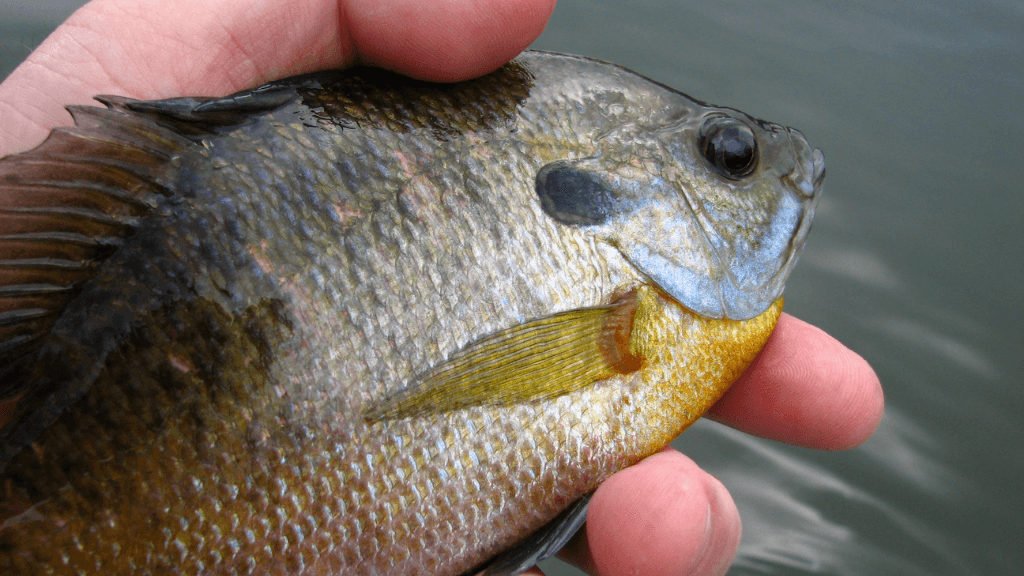These scrappy fish are one of the most widely distributed species in the United States. Learning how to catch bluegill is relatively easy, but that doesn’t make it any less fun.
These small panfish know how to put up a fight! They’re also downright delicious when lightly battered and fried.
Of course, like any fish, catching bluegills takes some know-how and technique. So, below I’ll discuss everything you need to know about how to catch bluegill, no matter your location or season.
Bluegill Basics
Bluegill is a member of the sunfish family, which also includes the largemouth bass and several other popular species.
These flat and round-shaped fish are easy to identify thanks to their dark blue or black operculum, which is a fancy term for their ear flap. They can be a variety of colors, from dark blue to yellow or orange. They’re even near-transparent sometimes!
Regardless of color, though, they all have six to eight vertical bars along their sides. How prominent those bars are will vary from fish to fish. All bluegill also have pointed pectoral fins.
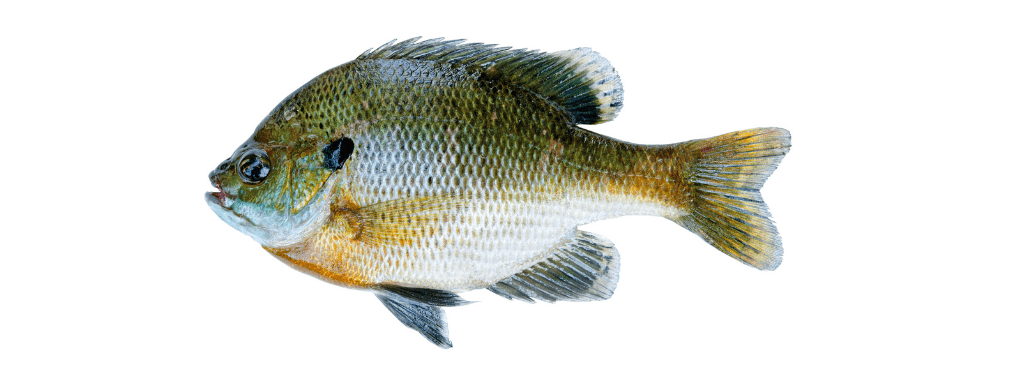
Bluegills often measure about 7.5 inches long and usually weigh between one and two pounds. Though the heaviest recorded catch weighed in at 4.8 lbs, a whopping size for bluegill.
Don’t let their small size fool you, though. Bluegill put up a mighty fight, given their size and weight. Some anglers even quip that if a largemouth bass were as feisty as bluegill, it’d be impossible to reel in! That’s why they’re so much fun to catch.
Bluegills are found in lakes, ponds, and fishing holes from Mexico to Canada. They are a freshwater species and bluegill cannot survive in saltwater. They are easiest to find during the spawning season, in late spring and early summer when the water reaches 70- 75 degrees Fahrenheit.
At those times, male bluegills sweep out dish-shaped nests and aggressively defend them from predators. Usually, those nests are in shallow, shaded areas, near weed beds, wooded shores, or piers.
The rest of the year, bluegill locations are much more varied. Given their size, they have plenty of predators to dart and dodge, which means you’ll find them in mid-depth areas throughout lakes and ponds.
Bluegills are opportunistic feeders, dining on anything from small insects to minnows. Even the occasional small crustacean can become a bluegill’s dinner. They seem to love standard live bait options like crickets, mealworms, and grasshoppers. So these are perfect baits targeting bluegills.
That said, there are usually local regulations around fishing bluegill that anglers have to respect. Though the fish are common, they’re also necessary to a thriving water ecosystem.
If anglers catch too many, there won’t be enough for large predators like pike or bass. So, there tend to be rules determining fishing seasons and the size of your catch.
How to Catch Bluegill – 4 Bluegill Fishing Tips
Learning how to catch bluegill isn’t difficult. But, following these few essential tips will make you much more successful.
1. Use Light Tackle
Bluegills are small, so you’ll want a super light rod, as well as a light line. Together, they’ll ensure you feel when a bluegill bites.
Light lines are also harder for the bluegill to see in clear water locations like ponds or fishing holes. Go with a line weight between two and six pounds test for best results.
2. Use Small Baits
As mentioned, bluegills love small insects and bugs, like crickets or mealworms. That’s because tiny creatures are all that will fit in a bluegill’s mouth. So, whether you use live bait or lures, you’ll need to keep it small; less than an inch long is preferable.
Many bluegill enthusiasts swear by using live bait, and its true live bait will often catch you the most fish, but not always the biggest.
If you’re going to use live bait, you can use any number of insects, from crickets to red wigglers. Live crickets work particularly well. You can also use worm segments, just enough to cover your hook.
To catch the biggest bluegills (also known as bulls), you may want to consider an artificial lure. Grubs combined with a 1/64 -⅛ oz lead head jig are often the most effective synthetic option. The grub should be short and stubby, with either a single or split tail.
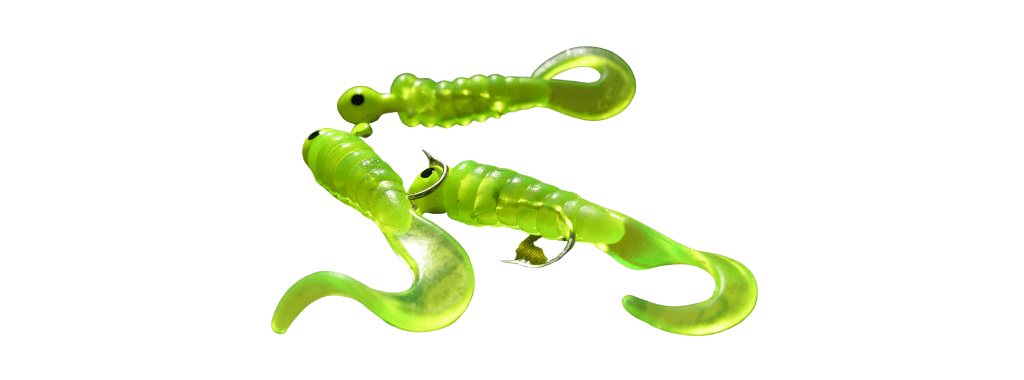
If you’re dealing with cloudy water, try picking an incline spinner instead. Small models in black, metallics or fluorescent colors work best.
In any case, use a thin wire hook between size no. 6 and size no. 10 with long shanks. The longer shanks make it easier for you to remove from the bluegill’s tiny mouth. And thin wire hooks are always the best option when dealing with small bait.
3. Try Fly Fishing or Using a Bobber
You can catch bluegill using a variety of techniques like:
● drift fishing
● fly fishing
● bobber fishing
● bottom fishing
But, some techniques work better in certain situations than others. Below, we’ll discuss fishing bluegill by season so you know when to use each method.
Surprisingly, fly fishing bluegill works well in all four seasons. Though many think fly fishing is synonymous with catching trout, you can also catch bluegill with this fun and exciting technique.
Unlike many species of trout, bluegills aren’t picky about the flies. They’ll bite just about any artificial fly, as long as it’s small enough, though they may have a preference for the color black.
The trick with bluegill is to move slowly. They don’t like to chase their food, and if they miss a quick-moving fly, they’ll lose interest. By keeping the fly slow-moving or suspended, you’re more likely to make a catch.
If fly fishing isn’t your thing then try using a slip float. A slip float is like your standard bobber but the biggest advantage is that they don’t interfere with casting.
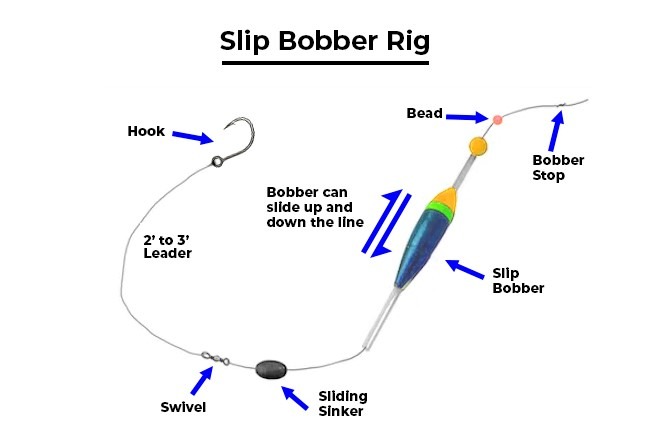
You put your line through it, attach a stop, and adjust the depth. You set the distance between the float and the terminal tackle while bringing the line in for a cast.
If you don’t have a slip float on hand then standard bobbers using a number 6 hook work well. They catch panfish of all kinds and bluegill is no exception.
4. Find Remote Locations
Bluegills are in almost every lake, pond, and lagoon throughout the United States. But, where there’s lots of fishing competition, you will find that bluegills are harder to catch.
That’s why some of the biggest bluegills are often found in small farm ponds and small, remote lakes.
If you happen to know a farmer or even an extra-friendly golf course owner, ask if you can fish their ponds now and then. You’re more likely to catch a big bull there than you are at a busy, tourist-filled lake.
Of course, even in bigger state park lakes, like Reelfoot in Tennessee, you’re likely to find bluegills in mass, though they may be on the smaller side. Still, you shouldn’t underestimate them – even smaller bluegills can put up a mighty fight!
Bluegill Fishing in Late Spring and Early Summer
In late spring and early summer, bluegills build and defend their nests. That makes them much easier to catch than in other parts of the year. You can often see the nests on the shallow bottoms of lakes and ponds.
Some describe the groups of craters as “elephant tracks,” and it’s a fitting description. As it does look a bit like a herd of elephants waded through the pond just hours before.
At this point in the year, male bluegills are large and aggressive. They’ll bite at anything that comes near their nests, but anglers need to be careful not to spook them all the same. So, it’s best to cast beyond the nests and then retrieve the bait, pulling back through the colony at a slow pace.
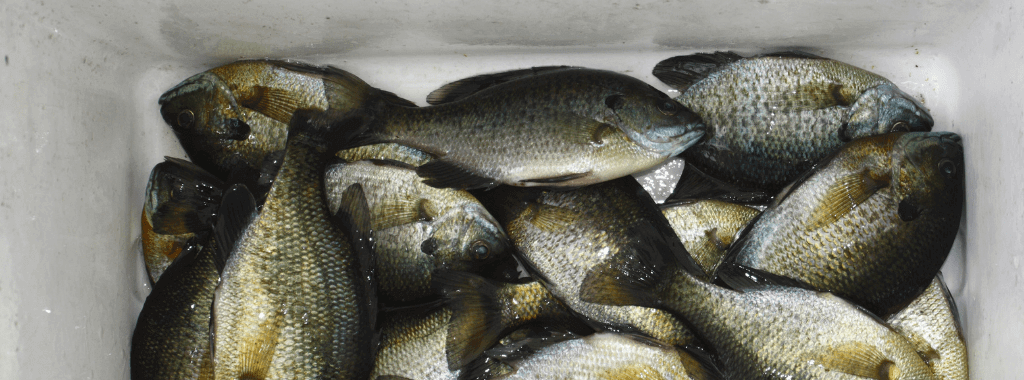
This is also a good time to use a bobber and bait, which is a popular method for catching bluegill. This is especially true for younger anglers. Kids can set a small bobber at one to three feet deep and if they make slow movements or no movement at all, will likely get a bite.
The bobber needs to be small so that the fish doesn’t feel any resistance when it bites. If it feels too much resistance, it will spit out the bait.
Some anglers choose not to fish for bluegills during spawning season out of sustainability concerns. While bluegills are easy to catch at this point of the year, it’s also when they repopulate their ecosystem. This ensures larger predator fish will also thrive in future seasons.
For them, the best time to catch bluegills is in early spring, before the males begin to sweep out nests. I’ll cover tips and tricks to catch them in that season below.
Late Summer
By late summer, the spawning season is over, and bluegills are back to roaming the waters in schools. They’ll have moved from the shallows and into mid-depths, where drift fishing might work best.
By drifting a boat across a lake or pond while trailing bait at between ten and fifteen feet below the surface, you’ll likely catch a bluegill or two. Once you make a catch, repeat the drift in the same area. With any luck, you’ll be able to catch several bluegills from one school.
During the summer, bluegills will be most active during the morning and evening hours, when the water is calmer and the fish are hungry. It’s best to avoid midday, but if you are fishing in the heat of the day, try targeting deeper areas. Bluegill will retreat to cooler deeper areas where oxygen levels in the water remain higher. Areas below ten feet can be surprisingly productive.
Fall
When fall comes around and temperatures cool, bluegills may move to even deeper water. You could use pretty much any technique to catch bluegills around this time, as long as you sink your bait below ten feet deep.
You also may find that midday fishing is ideal for fall. Unlike summer, when bluegills tend to bite in the early morning and evening hours. Come autumn, they’re more likely to be active around the middle of the day.
Winter
Bluegills are winter fishing favorites. Though they’re not as active of feeders in the winter months, they’re still relatively easy to catch, even in ice-covered ponds.
At this point, you’ll want to look for them somewhere between twelve and twenty feet deep. They tend to school near underwater structures at the bottom of lake beds and ponds.
By presenting the bait slowly, you’ll likely attract a few, but you’ll want to be sure you’re using exceptionally light tackle and line. In winter bluegills aren’t as active as in summer and spring. So they’ll bite hesitantly, and you won’t feel it unless your tackle is extra sensitive.
Ice fishing, in particular, is popular for bluegills. Using an ice jig or marabou jig works best, especially if they’re painted in a fluorescent hue. Waters are dark this time of year, and the bright colors can attract a fish that wouldn’t be interested otherwise.
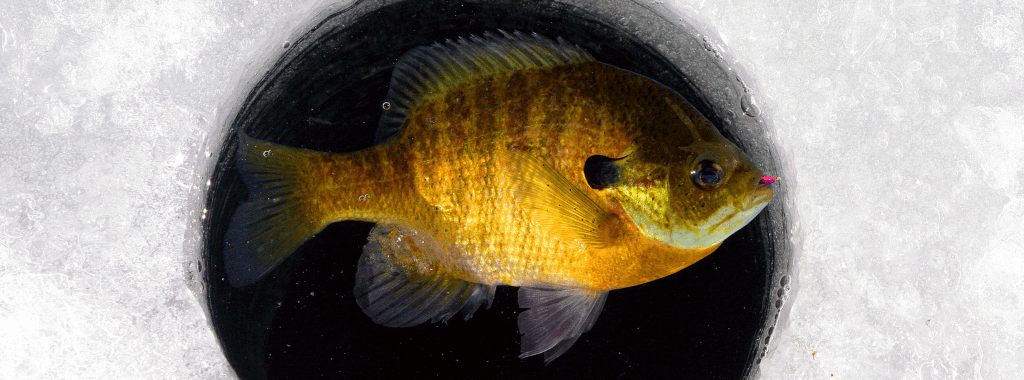
When it comes to ice fishing techniques, anglers seem to have the most luck when they set their bait within one foot of the bed. Then, they twitch it every thirty seconds or so.
It takes close and careful watching to feel a bite, and newer anglers may do better with a bobber attached at the level of the ice. The bobber will help them identify any light takes so they don’t miss the chance to catch a delicious panfish.
Early Spring
Many anglers find that early spring is their favorite time to catch bluegills. At this point, the water is still cool, and the fish are often still deep. But, they’re beginning to ready themselves for spawning season and maybe more aggressive in their feeding.
They also may push into shallows on warmer, more buggy days. At which point, they’ll likely bite at almost anything you drop.
On cool early spring days, though, bottom fishing might be the best way to catch a bluegill. To bottom fish, anglers cast their lines and then let the bait slowly sink, all the way to the bottom of the lake or pond. With a bit of luck, bluegill will bite as the bait falls past them.
If there’s no bite, give the bait a few minutes at the bottom and watch the line closely to see if a bluegill tries to pick the bait off of the lake’s floor. If you don’t see anything after a few minutes, it’s best to reel it in and recast.
Final Thoughts
Bluegill put up a mighty fight for their size and weight. That’s why they’re so much fun to catch and they are great eating too.
If you ask any angler what hooked them on fishing, many will say that it was bluegill fishing that got them started.
While bluegill fishing might not win you any trophies or make the day’s headlines, it’s always a great pastime. So now you are armed with these tips on how to catch bluegill get out there and give it a go.

